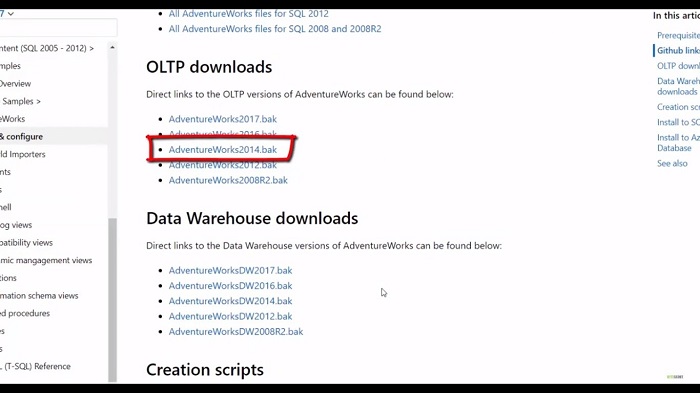

Using this way SQL Server run the multiple thread of database backups for each files and can be completed faster comparatively with less time and IO. SQL Server have one more feature to database backups can split to multiple files. Back up the AdventureWorks transaction log as copy onlyīACKUP LOG AdventureWorks TO DISK = N'c:\n' WITH COPY_ONLY Back up the AdventureWorks database as copy onlyīACKUP DATABASE AdventureWorks TO DISK = N'c:\AdventureWorks.bak' WITH COPY_ONLY
Adventureworks2012 quiz full#
A copy-only full backup can’t be used as a basis for a differential backup, nor can you create a differential copy only backup. TO DISK ='D:\AdventureWorks_FileGroup.bak'Ĭopy-only backups are introduced in SQL Server 2005 and are used to create a full database or transaction log backup without breaking the log chain. BACKUP DATABASE AdventureWorks FILEGROUP='PRIMARY', FILEGROUP ='Secondary' Another potential benefit of having filegroup backups is that if the disk on which a particular file resides fails and is replaced, just the file can be restored instead of the entire database. These backups are essential when the database size is so large that backups must be done in parts because it takes too long to backup the entire database. Using the file or filegroup backup you can backup an entire filegroup or files within the filegroup. Back up the AdventureWorks transaction logīACKUP LOG AdventureWorks TO DISK = N'c:\n' Without Transaction log backups you can restore data only till the time when the full or differential backup was taken. Log backups are taken between full backups to allow point-in-time recovery with the exception of log backups containing bulk-logged records. Simple recovery model does not allow transaction log backup because the log file is truncated automatically upon database checkpoints. Log backups can be taken only if the recovery model of the database is Full recovery or Bulk-logged recovery. Back up the AdventureWorks as differential backupīACKUP DATABASE AdventureWorks TO DISK = N'c:\AdventureWorksDiff.bak' WITH DIFFERENTIAL When you restore using differentials you must first restore the full backup followed by the most recent differential backup that was taken. In addition to being smaller and faster than full backup, a differential backup makes the restore process simpler. For larger databases differential backups is common in order to save space and reduce the backup time. A differential backup is not a stand-alone backup it needs a full backup to act as a baseline. Back up the AdventureWorks as full backupīACKUP DATABASE AdventureWorks TO DISK = N'D:\AdventureWorks.bak'ĭifferential backup backups up only the data that has changed since the last full backup. It serves as a baseline for all other backups. Full backup should be a part of backup strategy for all the business-critical databases.įull database backup contains the complete set of data needed to restore and recover a database to a consistent state. We have below type of backup available in SQL Server 2012.Ī full backup is a backup of the entire database that contains all the data and log file records needed to recover the database to the point in time when backup completed.


 0 kommentar(er)
0 kommentar(er)
